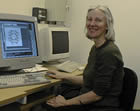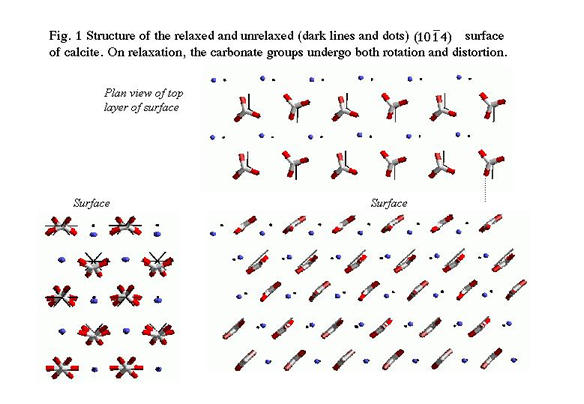
|
 |
Academic staff - Dr Kate Wright - Computational Chemistry
 |
- Sulfide mineral reactivity
- Computer simulation of minerals
- Defects in materials
- Surface science
|
Dr Kate Wright no longer works at the UCL Chemistry Department.
My research revolves around the central theme of Computer Modelling of Minerals using atomistic, semi-empirical and electronic-structure methods. I particular, I am interested in the nature of defects in minerals and their influence on reactivity, both in the bulk and at the surface, and in the nature of the mineral-water interface. At present, research is being carried out in three broad areas.
1) Modelling the structure and reactivity of metal sulfide minerals.
Computational studies currently underway are aimed at understanding the surface reactivity of metal sulfides (e.g. PbS, ZnS, FeS2, CuFeS2) and have applications to mineral processing, and to environmental problems related to the management of mine wastes.
2) Surface studies of carbonate minerals.
The surface reactivity of calcite (CaCO3), and the related carbonate minerals dolomite (MgCa(CO3)2) and magnesite (MgCO2, is a key factor in the chemical control of aquatic environments, in diagenesis, in the cycling and entrapment of metal contaminants, the biogeochemical cycle of carbon, and in a variety of industrial processes. Recent work has focussed on investigating the differences and similarities of the hydrated surface structure
3) Modelling hydrogen speciation in silicate minerals.
The Earth's upper mantle is composed of dense, (MgFe) silicates which, although nominally anhydrous, contain water in the form of H defects. Computer simulation techniques are being used to study the mechanisms of hydrogen uptake in these minerals and the nature and the location of the H-defects in their structure.

Selected Publications
- Wright, K. and Catlow, C.R.A. (1996) Calculations on the energetics of water dissolution in wadsleyite. Phys. Chem . Minerals. 23:38-41
- Catlow, C.R.A., Cherry, M., Chow, K.H., Cottrell, S.P., Cox, S.F.J., Davis, E.A. and Wright, K.V. (1997) Modeling hydrogen in silicate minerals. Hyperfine Interactions 106: 119-122.
- Wright, K., Watson, G.W., Parker, S.C. and Vaughan, D.J. (1998) Simulation of the Structure and Stability of Sphalerite (ZnS) Surfaces. Amer. Mineral 83:141-146
- Wright, K., Hillier, I.H. and Kresse, G. (1999) Dissociation of water on the surface of Galena (PbS): A comparison of periodic and cluster models. J. Chem Phys. 111:6942-6946.
- Steele, H., Wright, K., Hillier I.H. and Nygren, M.A. (1999) Interactions of the (001) surface of muscovite mica with Cu(II), Zn(II) and Cd(II): a computer simulation study. Geochimica Cosmochim. Acta. 64:257-262.
- Wright, K.V., Cygan, R.T. and Slater, B. (2000) Modelling the structure of the surfaces of calcite, dolomite and magnesite under wet and dry conditions. PCCP Submitted.
This page last modified
9 August, 2010
|
 |




|
![]() +44 (0)20 7679 4650 - Copyright © 1999-2010 UCL
+44 (0)20 7679 4650 - Copyright © 1999-2010 UCL